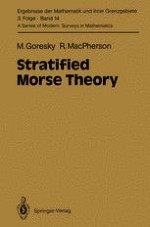1988 | OriginalPaper | Chapter
Introduction
Authors : Mark Goresky, Robert MacPherson
Published in: Stratified Morse Theory
Publisher: Springer Berlin Heidelberg
Included in: Professional Book Archive
Activate our intelligent search to find suitable subject content or patents.
Select sections of text to find matching patents with Artificial Intelligence. powered by
Select sections of text to find additional relevant content using AI-assisted search. powered by
In this section we consider the topology of the complement $$ M = {{\mathbb{R}}^{n}} - \bigcup\limits_{{i = 1}}^{m} {{{A}_{i}}} $$ of a finite collection A = {A1, A2,…, A m } of linear affine subspaces of Euclidean space ℝn. (The subspaces can be of arbitrary dimension, and do not necessarily contain the origin.) We give a combinatorial formula for the homology of this complement, which depends only on the partially ordered set P whose elements v are the intersections of the subspaces (ordered by inclusion), and on the dimensions of these “flats” (see Sect. 1.1, “statement of results”). Complements of hyperplanes have received considerable attention during the last ten years ([Ar], [Br], [Ca], [D2], [OS1], [OS2], [Zas]) and a nice survey article on the subject is [Ca]. In the case that the collection A consists of real hyperplanes, our formula reduces to Zaslavsky’s formula [Zas] for the number of connected components of M. If A is the underlying real arrangement of an arrangement of complex hyperplanes in ℂn/2 then our formula reduces to the Orlik-Solomon formula ([OS1]). It is interesting that in this case, the complex structure is irrelevant except that it guarantees that each flat is even-dimensional. In particular, our approach clarifies the connection (as observed in [OS1] and [OS4]) between real and complex arrangements in the following corollary.
